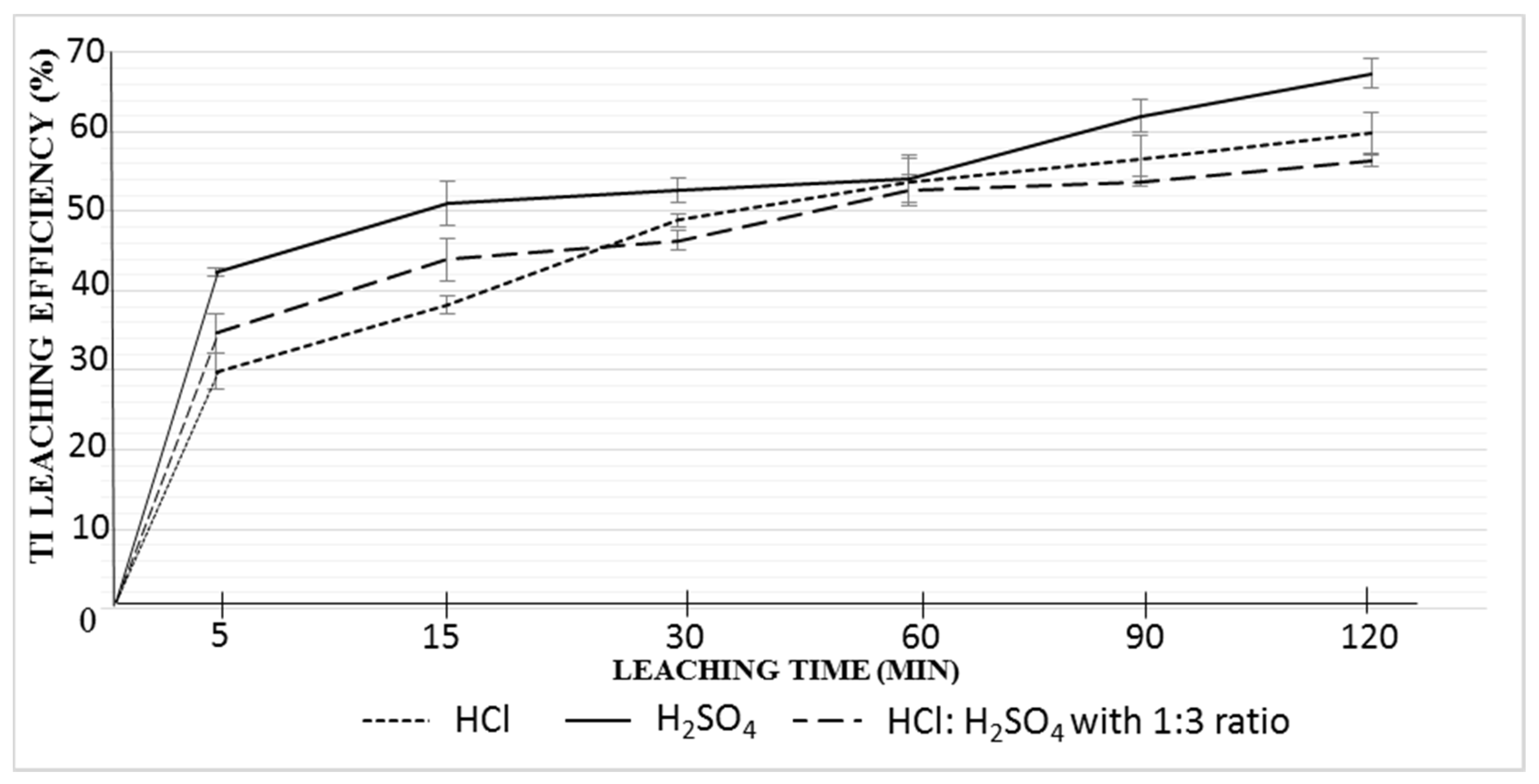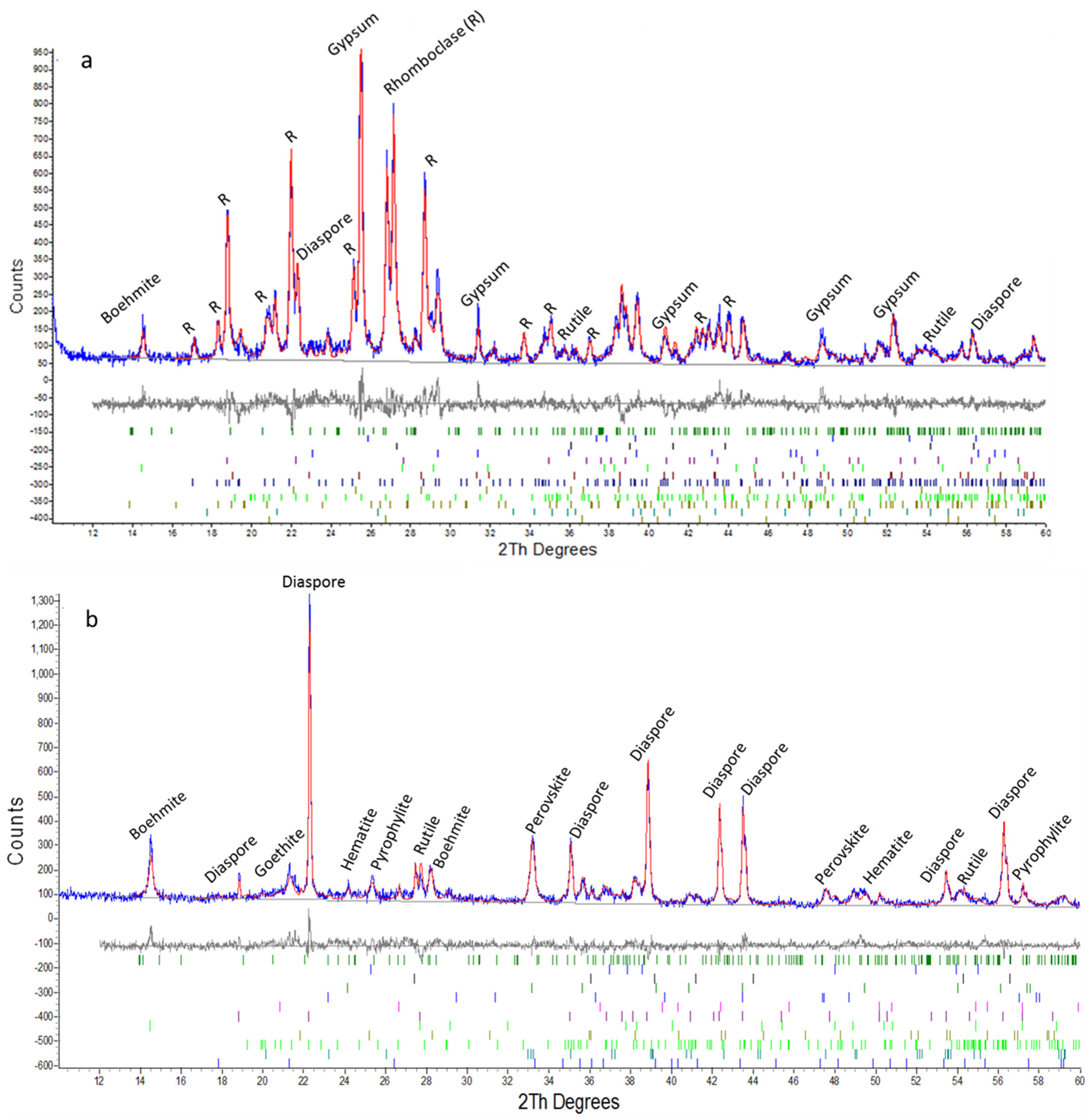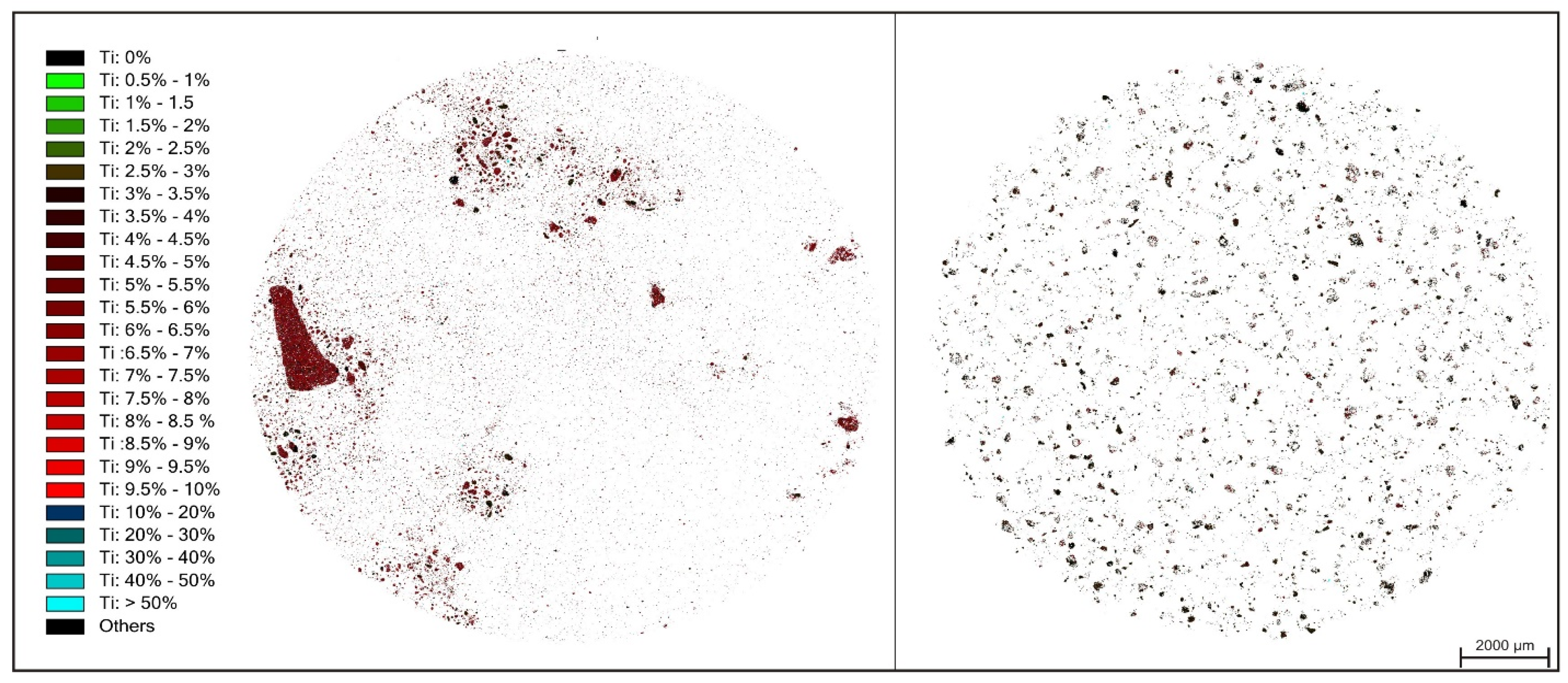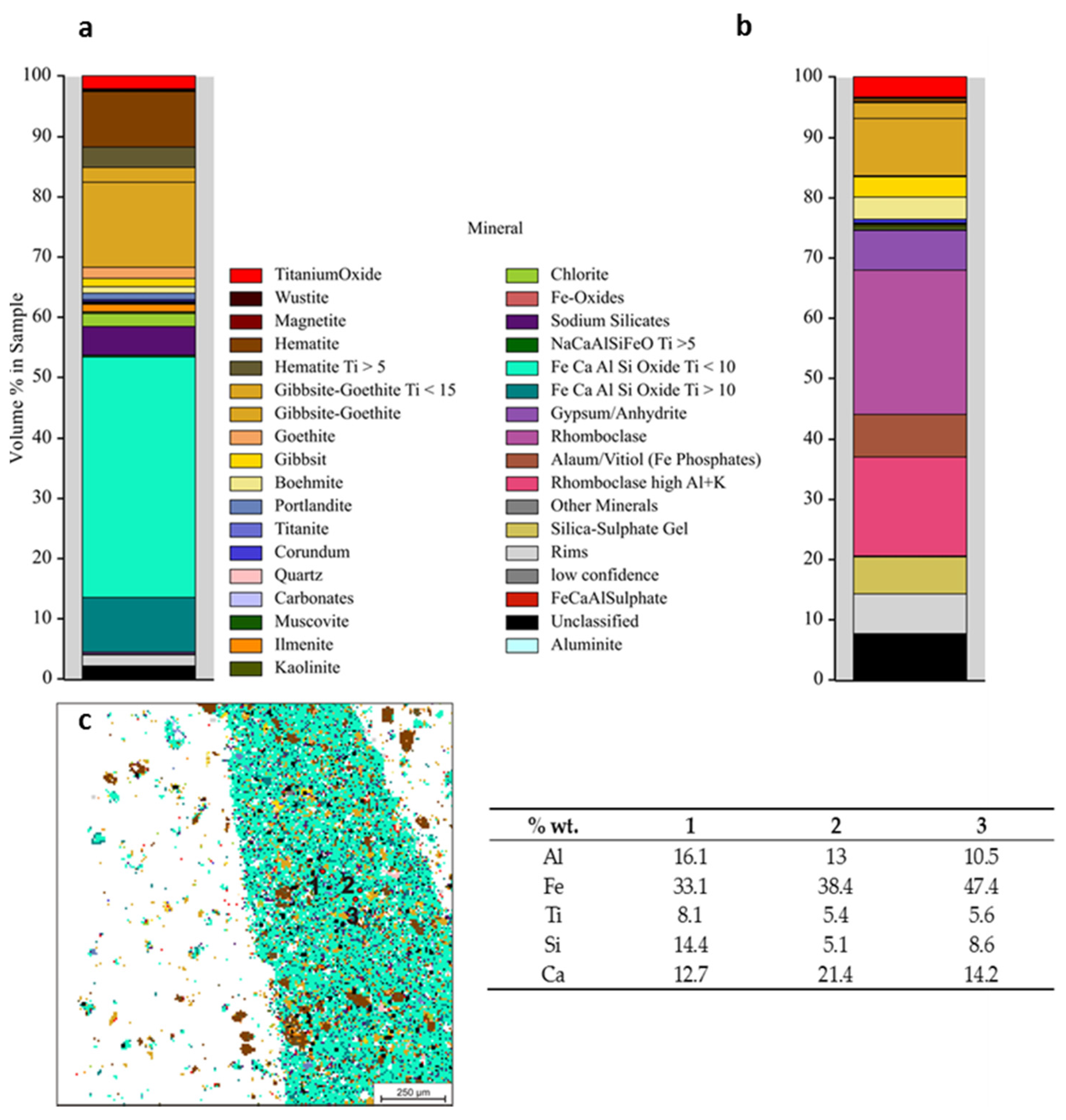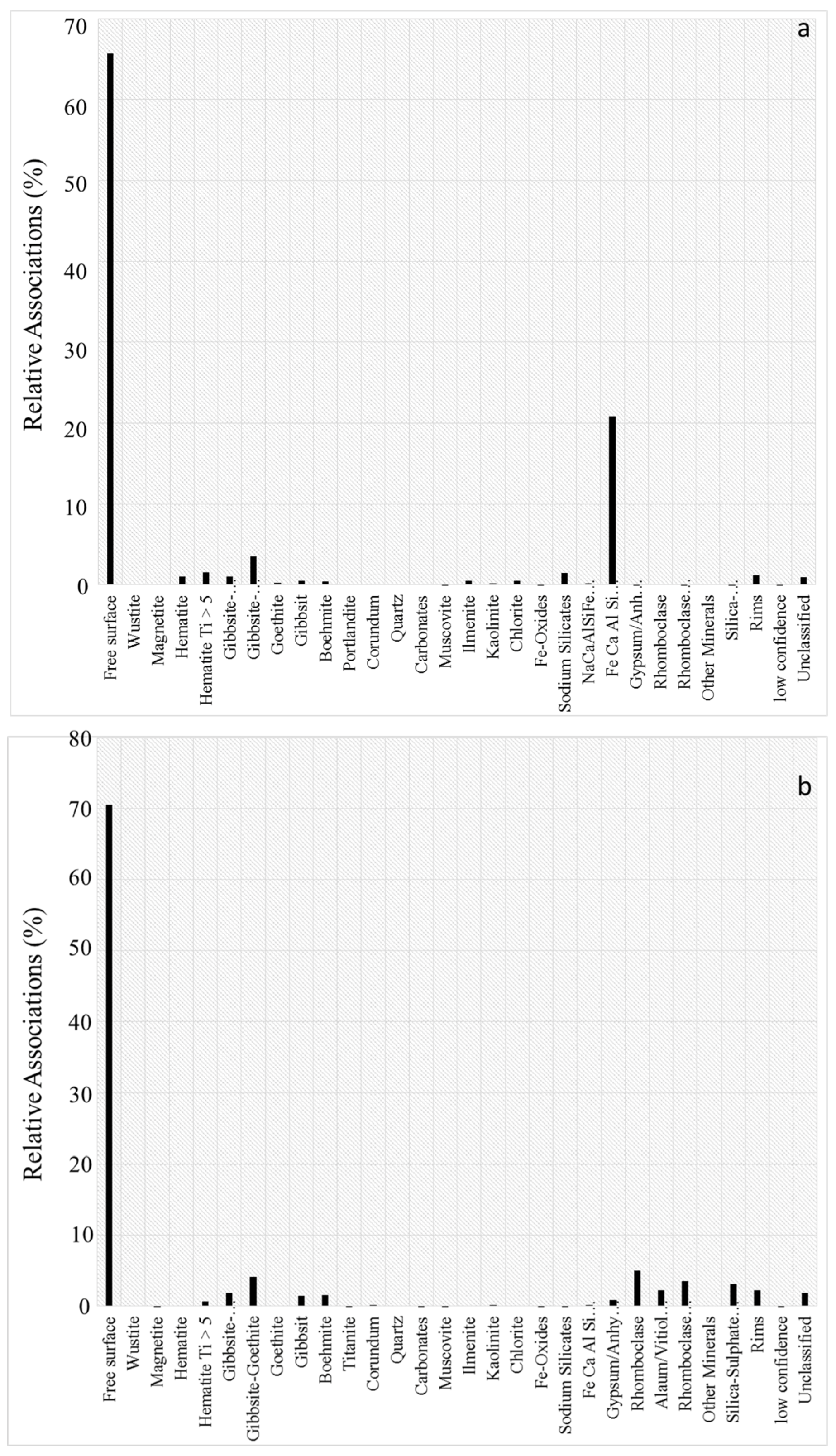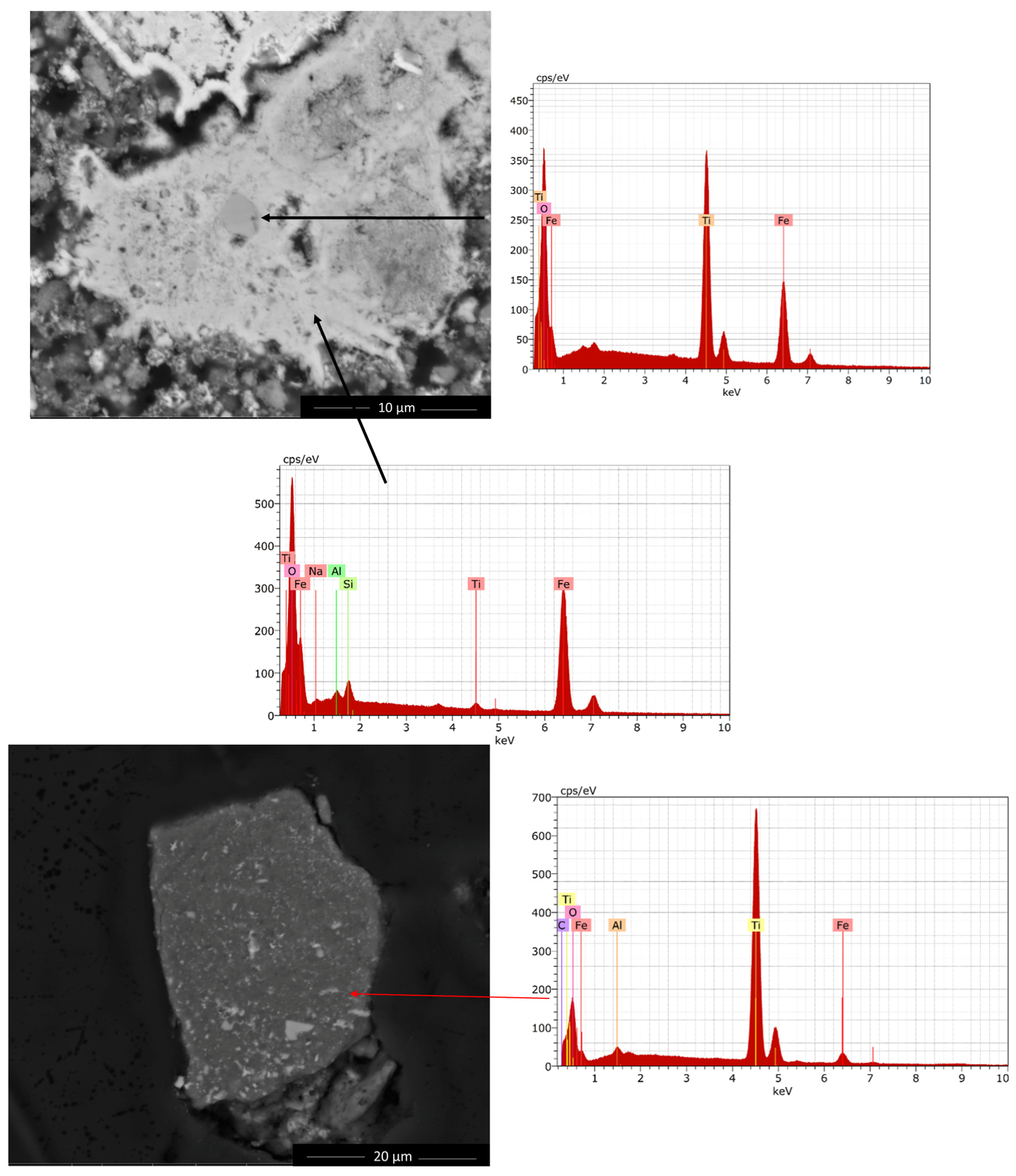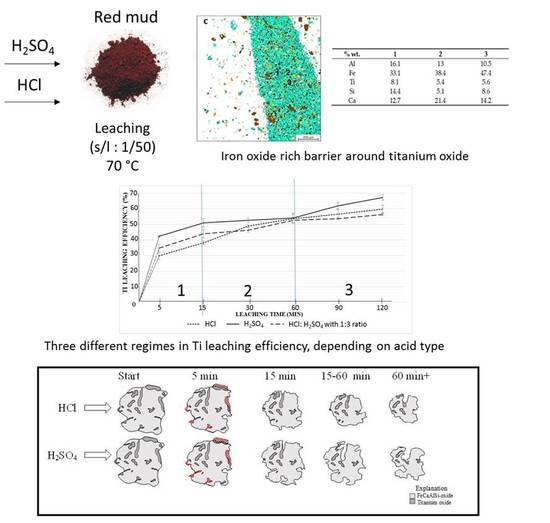3. Results and Discussion
The evaluation of titanium leaching efficiencies as a function of reaction time can be seen in
Figure 1. The graph represents the average leaching values, including deviations due to test repetitions. At the end of two hours, the highest leaching efficiency of titanium (67.3%) was achieved with sulfuric acid, followed by hydrochloric acid (59.8%) and the combination of HCl to H
2SO
4 with a ratio of 1:3 (56.4%).
Moreover, the time dependent evaluation of leaching efficiencies revealed variable kinetic profiles after three different acid treatments. In the first 15 min of leaching, for all acid types, higher leaching rates were observed by a higher slope of the curves. After 15 min, in the case of H2SO4, the leaching rate decreases until 60 min test duration. In contrast, during this period (15–60 min), there is still high leaching rates observed with hydrochloric acid. After 60 min, it is seen that the HCl leaching curve gets closer to saturation and leaching becomes slower, while H2SO4 reaches higher rates and superior leaching efficiency. The course of the combination of hydrochloric- and sulfuric acid is characterized by less significant leaps. From this data it is seen that the most efficient leachate in terms of final leaching efficiency for Ti is sulfuric acid. However, the findings on leaching kinetics induced the detailed investigation of leaching to explain different mechanisms by different leachates and find an optimum process condition.
Using X-ray diffraction, the phase content of solid residues after HCl and H
2SO
4 treatment were investigated to reveal the effect of acid type on leaching mechanism. Related XRD analyses are given in
Figure 2a,b for direct comparison purposes.
XRD analyses revealed the differences in phase contents of leach residues in terms of titanium (Ti), iron (Fe) including phases, which may explain the different leaching behavior of two acids. As listed in
Table 2, total amount of Fe including phases (hematite (5.3%) and goethite (6.3%)) are low in HCl solid residue. Nevertheless, it is seen that H
2SO
4 residue is much more enriched in terms of Fe compounds such as, rhomboclase, another iron sulfate and trace amounts of goethite. A higher amounts of Fe is found as rhomboclase (57.4%) which is formed by re-precipitation of dissolved Fe ions with sulfate. In the presence of sulfate ions and highly acidic conditions provided by concentrated H
2SO
4 leachate, the precipitation of dissolved Fe into rhomboclase is thermodynamically more favorable and may result in less leaching efficiency of Fe [
9]. Quantitative analyses of residues imply in parallel with ICP analyses, higher Fe dissolution rates in the presence of HCl. Moreover, at the end of 2 h HCl leaching, Ti was detected in HCl leach residue in the form of perovskite (3%) and rutile (1.5%). In contrast, Ti was found only as rutile (0.58%) and anatase (0.81%) in the H
2SO
4 leach residue with relatively lower amounts (see
Table 2), implying higher leaching efficiencies in parallel with ICP findings. Perovskite may be consumed by the reaction of calcium with sulfate ions and precipitate into gypsum as revealed in X-ray diffractogram of H
2SO
4 slag; which may also favor Ti extraction from perovskite. Higher Ti and lower Fe leaching efficiencies with H
2SO
4 favor its utilization for selective Ti leaching from red mud.
Nonetheless, when 4 wt % content of Ti in red mud and even lower value for residue is considered, XRD is not highly sensitive to reveal changes in Ti including phases. This lack of sensitivity induced QEMSCAN utilization which can deal with elemental and phase mappings, phase associations and available surface area detections for red mud and the most promising leachate (H2SO4) residue.
In
Figure 3, the Ti elemental mapping of red mud and leach residue are given together for direct comparison purposes. The field scan image of red mud in
Figure 3 revealed that Ti content of red mud phases is inhomogeneous with a maximum amount of 8–9 wt %. After leaching, a dramatic change in distribution is observed, which exhibits homogenous and finely distributed Ti through the minerals of H
2SO
4 residue with a decreased amount at a maximum 3–4 wt %.
Beyond elemental mapping, the mineral distribution within red mud and H2SO4 leach residue were also investigated in a comparative manner.
In addition to phases indicated by XRD, QEMSCAN, analysis given in
Figure 4 revealed the presence of large amounts of Fe-, Ca-, Al-, Si mixed oxide in red mud, where a certain amount of TiO
2 is entrapped. Due to the heterogeneous nature of this complex oxide, chemical composition and stoichiometry vary through the volume. Therefore, a crystalline phase could not be assigned. Varying compositions revealed by point 1, 2 and 3 imply that this complex oxide may be aggregate or intergrowth of several oxides inherent from Bayer Process. After leaching with H
2SO
4, as represented in the mineral distribution in
Figure 4b, it is seen that most of this various composed oxide is leached out and rhomboclase formation takes place as consistent with XRD analysis. In leach residue, a limited amount of TiO
2 is detected only within gibbsite-goethite as revealed in
Figure 4b.
The mineral association analysis revealing free available surfaces and contacts between phases is represented in
Figure 5a,b for red mud and H
2SO
4 leach residue respectively.
Figure 5a exhibits that certain amounts of TiO
2 surfaces are in contact with Fe-, Ca-, Al-, Si-oxide. The remaining TiO
2 was found with free available surfaces, which may result in fast leaching kinetics in the very early stage of leaching revealed by ICP analyses given in
Figure 1. In comparison with red mud, when H
2SO
4 leach residue is considered as represented in
Figure 5b, it is seen that most of the TiO
2 surfaces are free and available, just very negligible quantities are in contact with rhomboclase and gibbsite-goethite. These findings reveal that the Fe dominating complex composed oxides form a diffusion barrier between TiO
2 and leachate and may be the reason for the deceleration of reaction kinetics in the middle period of the trial.
Red mud and H
2SO
4 leach residue were investigated in a comparative manner by SEM to reveal morphological changes taking place during leaching, as represented in
Figure 6. In order to reveal elemental composition, Energy dispersive X-Ray analyses (EDX) was also utilized.
Relatively large aggregates around 30 µm of Fe (also Al, Si and Na including) dominating oxides have been revealed where 2–3 µm sized TiO
2 is entrapped in parallel with findings of QEMSCAN. This micrograph emphasizes that in order to reach to TiO
2 enriched compound, the more iron oxide enriched phase should be leached out. On the other hand, leach residue exhibited relatively finer particles with respect to coarser aggregates of red mud. Moreover, in leach residue, mostly TiO
2 is detected with free surfaces and small contact with Al dominating oxide where some Fe is also present, as represented in
Figure 6. This is consistent with QEMSCAN analyses which indicates mostly free surfaces of TiO
2 and a trace amount of contact with gibbsite-goethite.
Presence of both free and entrapped TiO
2 surfaces revealed by SEM and QEMSCAN may be responsible for various leaching kinetic regimes within various stages of reaction. Since leaching starts from surface, initial high leaching kinetic for all acid treatments is owing to easy access to TiO
2 surfaces. The second regime, as observed in
Figure 1, starts from 15 min of reaction where H
2SO
4 has slower and HCl similar behavior with respect to the first regime. It is worth emphasizing that as reported in previous studies, H
2SO
4 is more sensitive to TiO
2 leaching where HCl was used to dissolve Fe [
10]. Their selectivity to metal types may be the reason for different kinetics in the second regime. Faster Fe leaching in the earlier stages of reaction by HCl ensures leachate to access TiO
2 entrapped in Fe dominating oxide. Relatively lower leaching rates of Fe in the case of H
2SO
4 may result in highly pronounced diffusion barrier effect of Fe enriched oxide for leaching of TiO
2 However, after this time H
2SO
4 achieves higher kinetics, most probably due to increased Fe leaching with longer reaction times. In the end, H
2SO
4 yields in higher Ti leaching efficiency as consistent with previous studies [
10,
11].
Iron oxide enriched phase inhibiting effect implied by SEM and QEMSCAN is analyzed by ICP measurement to reveal Fe leaching rates with HCl and H
2SO
4.
Figure 7a,b represent leaching rates of Fe and Ti for H
2SO
4 and HCl respectively.
Figure 7a,b reveal that Fe leaching rates are similar in the early stages of leaching. However, after 15 min of reaction, Fe oxide dissolution is increased dramatically with HCl. Although they are quite similar in the early stages of reaction, after 15 min, an increase in HCl leach rate is observed while that in H
2SO
4 is still slow. After 60 min of reaction, only 30% of iron is leached out by H
2SO
4, while 46% by HCl. After 60 min, Fe leaching rate by H
2SO
4 becomes also higher and achieved to 47% at the end of 2 h, while HCl reached 55%. After 60 min, leaching rates of Ti by H
2SO
4 accelerates. Increasing Ti leaching rates with increasing Fe dissolution, in parallel with SEM and QEMSCAN analyses, indicate the obstacle effect of Fe oxide enriched mineral over Ti recovery. More leached out Fe enriched oxide favors the access of leachate to the entrapped TiO
2, which results in higher kinetics of H
2SO
4 in the last stage of the leaching.
In light of SEM, QEMSCAN and ICP analyses, a model for leaching process with HCl and H
2SO
4 are proposed as in
Figure 8. This model is based on already existing particle dissolution model in leaching, where the reaction starts from surface and propogates through the core.
After a period of 5 min, more TiO
2 is dissolved in sulfuric acid compared with hydrochloric acid. This can be seen in the red hatching in
Figure 8. Due to the higher sensitivity of hydrochloric acid leaching to iron, in the middle time of leaching after free TiO
2 surfaces are consumed, HCl achieves entrapped TiO
2 more easily and exhibits faster kinetics. However, after 60 min, H
2SO
4 also leaches a certain amount of Fe for the exposure of TiO
2 from the Fe Ca Al Si-oxide. The remaining TiO
2 particles are leached out after a time of 60 min and at the end of reaction less amount of TiO
2 remains in residue of H
2SO
4 with respect to that of HCl.
